dutchman
Spon End
|
31 of 80
Thu 24th Jul 2014 2:36pm
Quite right Prof  Link to text
Link to text
In the 1570s 'the Dirge Hall at Bablake, the wardens' chambers, the priests' chambers on the west side, and the schoolhouse were all laid out together, repaired, and some part rebuilt, to make a house of correction, commonly called Bridewell'. The Bridewell, which survived for more than 250 years, seems at first to have occupied the south range of the quadrangle and probably part of the west range also. The Dirge Hall was used at times by the Bridewell and at times for other purposes. By the early 19th century most of the west range had been demolished.
Link to map
|
|
Local History and Heritage -
Coventry's wells
|
Annewiggy
Tamworth
|
32 of 80
Sun 3rd Aug 2014 12:28pm
From Levi Fox's Coventry's Heritage, He says that a private scheme known as the Swanswell Waterworks had provided a piped supply of water to certain parts of the City since 1632 but most houses had to rely on the public wells and conduits. The chief conduits stood in Cross Cheaping, West Orchard, Smithford Street and by Bablake Church (known as the Bull Conduit), most districts had one or more wells, many of them fitted with pumps like the one utside St Mary's Hall/ The best known wells were Broad Well from which Well Street gets it's name, and Jordan Well named after its maker, Mayor Jordan Shepey. It was not until 1844 when the shortage of water became bad owing to the increase in population that Parliament's authority was sought for the construction of the Spon End waterworks and a main supply of water. The lovely colour picture from "Pictures in colour of Shakespeare Country" shows the pump outside St Mary's Hall.

 |
|
Local History and Heritage -
Coventry's wells
|
NormK
bulkington
|
33 of 80
Sun 3rd Aug 2014 1:20pm
I have encountered a few of these wells in my time on demolition. I remember one at Keresley where we had cleared some old cottages, it was very deep from the amount of time it took for a brick to hit the water. The pickup pipe was wooden, 1ft square, and in sections with a hole bored right through and tapered at the ends which made a seal. We managed to lift out 3 sections but after dark the kids had thrown my diesel barrel down it and blocked it. It must have been serious graft in those days digging these wells out and lining them with bricks as in your photo, Anne.  |
|
Local History and Heritage -
Coventry's wells
|
morgana
the secret garden
|
34 of 80
Sun 3rd Aug 2014 2:31pm
As the water from Corley that flows to Radford spring and the river Sherbourne I wonder if the Keresley well was from Corley.
I found this message board on how different ways old wells were dug and the dangers - link |
|
Local History and Heritage -
Coventry's wells
|
morgana
the secret garden
|
35 of 80
Sun 31st May 2015 11:28pm
|
|
Local History and Heritage -
Coventry's wells
|
Kaga simpson
Peacehaven, East Sussex
|
36 of 80
Mon 1st Jun 2015 5:20pm
There must have been dozens of them in my street alone. Most houses had a little hand pump to feed water from the well to the house way up until the early thirties. I find it most historic in the way our elders obtained water before the watermains were in action. Kaga. |
|
Local History and Heritage -
Coventry's wells
|
Helen F
Warrington
|
37 of 80
Mon 1st Jun 2015 5:53pm
I think it depends how far back you go. After they stopped drawing water straight from the river there would just have been wells, also called conduits. Later there were communal pumps, some in the street some in the courts. The household pumps were a late development. Maybe someone knows the time frame. |
|
Local History and Heritage -
Coventry's wells
|
mickw
nuneaton
|
38 of 80
Tue 2nd Jun 2015 11:39pm
This topic brings back childhood memories we had a well in the cellar of my parents off-licence in East Street the cellar was on two levels the well being in the lower part when we had heavy rain it would flood and us kids used to take turns on a hand pump to stop the water from rising to the upper cellar where the draught beer barrels were we used to have to prime the pump it was a right pain to get started especially when knee deep in water ha ha happy days.   |
|
Local History and Heritage -
Coventry's wells
|
dutchman
Spon End
|
39 of 80
Wed 3rd Jun 2015 12:07am
I think you mean a "sump" Mick? 
The Coombe Abbey Inn had a similar layout except that there were draught beer barrels in the lower section of the cellar as well. It was absolutely horrendous to work in. |
|
Local History and Heritage -
Coventry's wells
|
mickw
nuneaton
|
40 of 80
Wed 3rd Jun 2015 8:36am
Hi dutchman no it was definitely a well there was a pipe leading up to the kitchen with another hand pump I know what you mean about sumps in pub cellars it was far too wide and deep to be a sump. |
|
Local History and Heritage -
Coventry's wells
|
Norman Conquest
Allesley
|
41 of 80
Wed 3rd Jun 2015 10:15am
My brother once drove a dragline (RB 60) at Meriden Quarry. Came across brickwork and then a well. Brother dug carefully around the well and left it standing like a factory chimney. Of course that couldn't last and after a couple of days it fell over.
|
|
Local History and Heritage -
Coventry's wells
|
dutchman
Spon End
|
42 of 80
Wed 3rd Jun 2015 11:53am
On 3rd Jun 2015 8:36am, mickw said:
Hi dutchman no it was definitely a well there was a pipe leading up to the kitchen with another hand pump I know what you mean about sumps in pub cellars it was far too wide and deep to be a sump.
Ah, I see what you mean now.  I suspect it was taking advantage of the nearby Springfield Brook.
|
|
Local History and Heritage -
Coventry's wells
|
|
mickw
|
43 of 80
Wed 3rd Jun 2015 5:23pm
|
|
Kaga simpson
Peacehaven, East Sussex
|
44 of 80
Wed 3rd Jun 2015 6:00pm
The well Tekmelf found in his garden belonged to my aunt's house that got flattened in the bombing, the same raid that emptied the canal.
What I wondered, did they build the houses after they found water and built the wells.
In Ald Green Rd there were numerous houses built in a H or L shape with a small courtyard, some way back from the road and with signs of a hand pump, the pump was housed in a wooden box. The lever to the pump was about 3 ft long. The house I lived in was built so close to the rail lines, and yet there was plenty of ground for it to have been built further away, so I always wondered if it was built close to the water supply. Anyone know? |
|
Local History and Heritage -
Coventry's wells
|
dutchman
Spon End
|
45 of 80
Wed 3rd Jun 2015 9:10pm
On 3rd Jun 2015 5:23pm, mickw said:
Springfield Brook could that be where Spring Street got it's name I wonder.?
I think so? (Past experience has taught me never to sound too certain).
On 3rd Jun 2015 5:23pm, mickw said:
Concerning my parents off-licence at 102 East Street we believe it was a former bakery but have never found any history to prove this any ideas.?
None at all I'm afraid except to point out that many pubs brewed their own ale in those days and supplied nearby bakeries with the excess yeast.
|
|
Local History and Heritage -
Coventry's wells
|

![First page [or press the "F" key] First page](../resource/colour_tint_inc.php?img_file=left-arrow-end.png&clr=AA5511)
![Previous page [or press the "Left arrow" key] Previous page](../resource/colour_tint_inc.php?img_file=left-arrow.png&clr=AA5511)
![Next page [or press the "Right arrow" key] Next page](../resource/colour_tint_inc.php?img_file=right-arrow.png&clr=AA5511)
![Last page [or press the "L" key] Last page](../resource/colour_tint_inc.php?img_file=right-arrow-end.png&clr=AA5511)


